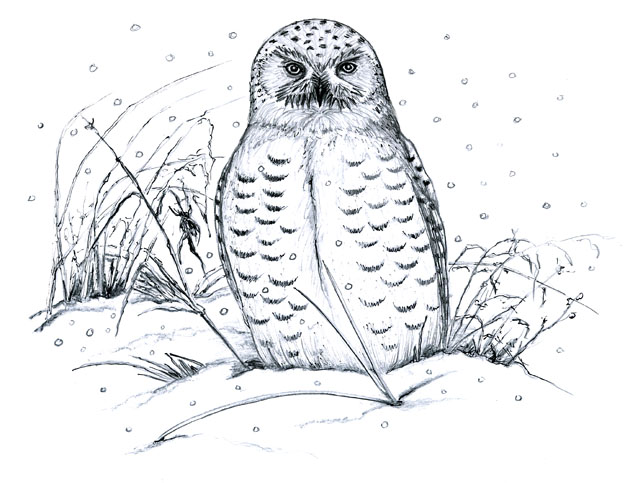
Dear Bird Folks,
A few weeks ago you wrote about how tough it is for sea ducks to ride out the winter in the open ocean. I’m wondering if the weather is tougher on inland birds. Ocean water tends to moderate the surrounding air temperature, thus it must be warmer for the ducks than it is for the birds wintering in the northern forests. Right? Also, which bird species can tolerate the coldest temperature?
– Rod, Syracuse, NY
Sure, Rod,
Why not? Since I don’t remember what I wrote in that duck column, and I’m too lazy to look it up – I’m not going to argue with you. If you think inland birds have it tougher than the ducks, so be it. Besides, you are from Syracuse, the city that invented winter. When it comes to cold weather you people know what you are talking about. I recently saw on the news that you had a whopping six feet of snow in the first two weeks of December. Six feet in two weeks! I didn’t hear what happened during the second two weeks of the month, but I assume you have gotten even more snow and now everyone in the city is dead. However, after receiving your note, I decided to rethink my assumption. It appears that at least you have survived. Whew! I hate to lose a reader, even one from Syracuse.
You are totally right. It is a lot colder inland than it is near the ocean. Birds that remain in the frozen north have to be extremely hardy. Which bird can tolerate the most cold? I’m not exactly sure but a prime candidate for the hardiest of them all has to be the Snowy Owl. Snowy Owls have been observed in temperatures that are 80 degrees below zero. That’s right, 80 below. (That’s the air temp, not the wind chill.) Try to wrap your head around that for a minute. At work I have the thermostat set at 62 degrees. I keep it low because I’m environmentally sensitive (plus I’m too cheap pay the heating bill). That temperature seems fine to me, but a few workers and customers complain that they are “freezing.” I tell these grumblers that Snowy Owls can survive when the temperature is 142 degrees colder and the owls never complain. So far this fact has failed to impress them.
Out of the roughly 10,000 different bird species in the world, only the Adele Penguins of Antarctica have feathers that provide better insulation than the ones on a Snowy Owl. And as opposed to the well insulated but bare foot ducks we talked about a few weeks ago, these owls have thick feathers covering their legs, their feet and even their beaks. Any birds that can survive 80 below zero would have to be tough and rugged, and Snowy Owls certainly meet these criteria. At nearly five pounds, snowies are North America’s heaviest owls and almost double the weight of their northern neighbor, the Great Gray Owl. They are also ferocious hunters, eating just about anything that moves including rabbits, muskrats, Canada Geese and Great Blue Herons. They will even pluck fish right out of the water. However, the Snowy Owls’ number one food of choice is a delicious lemming. Lemmings are small mammals of the tundra. It has been estimated that a single Snowy Owl may consume 1,600 lemmings annually. Even though lemmings are fairly chubby creatures, about the size of a baked potato, the owls can easily swallow one whole. Seeing an owl swallow something that large without chewing would totally freak out my mother. She always nagged us about chewing. Her favorite phrase was we have to “masticate” our food. I never wanted to do that because I was afraid I’d go blind.
Fortunately for the owls, lemmings are active year-round, living in tunnels that are both under the ground and under the snow. Owls have excellent hearing and appear to have the skill to locate and capture lemmings that are hidden below the snow. Lemming populations are constantly changing. Some years there are lemmings everywhere. During these years the owls are able to breed successfully and raise large families. Other years there are very few lemmings to be found. The powerful birds are somehow able to recognize that food is in short supply and will not breed at all during the lean years. The owls are smart enough to know that they shouldn’t crank out the kids if they aren’t able to provide for them. Humans could learn a lot from the owls.
The Snowy Owl fall migration is a complicated and poorly understood event. Most years the majority of these birds remain north of the U.S. border. But there are some years when thousands of them leave Canada and spend the winter with us. It was once thought that low lemming populations triggered these southerly migrations. However, recent research has failed to back up this theory. More studies need to be done. Unfortunately, it’s tough to find people who want to go out and study birds when it’s 80 below. Occasionally, even birders have common sense. Who knew?
So far, this has not been a great year for seeing Snowy Owls, Rod, but if any place is going to get them it will be Syracuse. I sure hope you aren’t the only person left in town who is alive. That would be very lonely. Although, repopulating an entire city could be kind of fun, if you know what I mean.